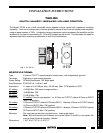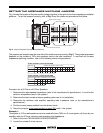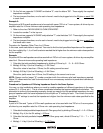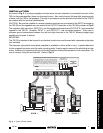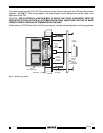
4
5. Next, calculate the overall paralleled impedance with the following formulae:
Z
O
= 1 ÷ [(1÷Z
1
) + (1÷Z
2
) + (1÷Z
N
...etc.)]
Z
O
= overall paralleled impedance
Z
1
= 1st paralleled group after S setting
Z
2
= 2nd paralleled group after S setting
Z
N
= additional paralleled groups, when used.
Since only two paralleled groups are used in this example, the calculation is as follows:
Z
O
= 1 ÷ [(1÷8) + (1÷9.12)] = 4.26 Ohms.
Since this yields more than 4 Ohms, the S4 setting for the 4 Ohm group and the S8 setting for the 8 Ohm
group are the correct ones to use.
Example 2:
2 pairs of 4 Ohm, 3 pairs of 6 Ohm and 3 pairs of 8 Ohm wall speakers are to be used with eight 760's in
an 8-room system, all driven by one amplifier rated for 4 Ohms minimum safe operating load impedance.
1. Calculate the total paralleled impedance of 4 Ohm group first, by dividing 4 Ohms by 2.
4 ÷ 2 = 2 Ohms.
2. Multiply 2 by 4 (for the S4 setting) =
8 Ohms.
3. Calculate the total paralleled impedance of 6 Ohm group next, by dividing 6 Ohms by 3.
6 ÷ 3 = 2 Ohms.
4. Multiply 2 by 8 (for the S8 setting) =
16 Ohms.
5. Calculate the total paralleled impedance of 8 Ohm group next, by dividing 8 Ohms by 3.
8 ÷ 3 = 2.67 Ohms.
6. Multiply 2.67 by 8 (S8 setting) =
21.36 Ohms.
7. Next, calculate the overall paralleled impedance Z
O
. Since three paralleled groups are used, the
calculation is as follows:
Z
O
= 1 ÷ [(1÷8) + (1÷16) + (1÷21.36)] = 4.27 Ohms.
Since this yields more than 4 Ohms, the S4 setting for the 4 Ohm group, the S8 setting for the 6 Ohm group
and the S8 setting for the 8 Ohm group are the correct ones to use.
Impedance Setting Tips
1. You may use the above method to calculate the correct impedance matching condition for practically
any combination of speakers and 760s.
2. Use the lowest "S" setting possible consistent with the requirement to keep above the minimum safe
operating load impedance for the amplifier. You may have to try 2 or 3 values of "S" for each impedance
group and recalculate the overall paralleled impedance Z
O
each time, before you arrive at the final
correct value.
3. When you test the system, you may find volume differences between the impedance groups when all
760s are set to max. volume. This is normal and is usually not a problem, since the user will be listening
at lower levels most of the time. If you feel it necessary to even out the volume levels, move the "S"
jumpers to the next higher number on the 760s that feed the loudest group.
NOTE: While speakers of differing impedance can be accommodated using these procedures, it is highly
recommended you not do so on a regular basis. The easiest and best performing installation is achieved
by using speakers of the same impedance throughout the entire system, referring to the charts for the
jumper "S" settings.
760-00



